MXA RACE TEST: THE REAL TEST OF THE 2020 YAMAHA YZ450F
THE COMPLETE REVIEW OF THE 2020 YAMAHA YZ450F
Q: FIRST AND FOREMOST, IS THE 2020 YZ450F BETTER THAN THE 2019 YZ450F?
A: Yes. Yamaha has been down a long, hard road over the last decade. It started in 2010 when Yamaha introduced its slant-back, reverse-cylinder engine. And while the 2020 YZ450F has by no means fixed all the peccadilloes that have vexed Yamaha for the last 10 years, it is the best overall YZ450F package since Yamaha won its last MXA 450 shootout back in 2006.
Q: WHAT HAS YAMAHA CHANGED OVER THE LAST 10 YEARS OF YZ450F R&D?
A: The technical changes that Yamaha made in 2010 to their YZ450F are still the subject of debate a decade later. Here is a quick history of YZ450F development steps over the last 10 years.
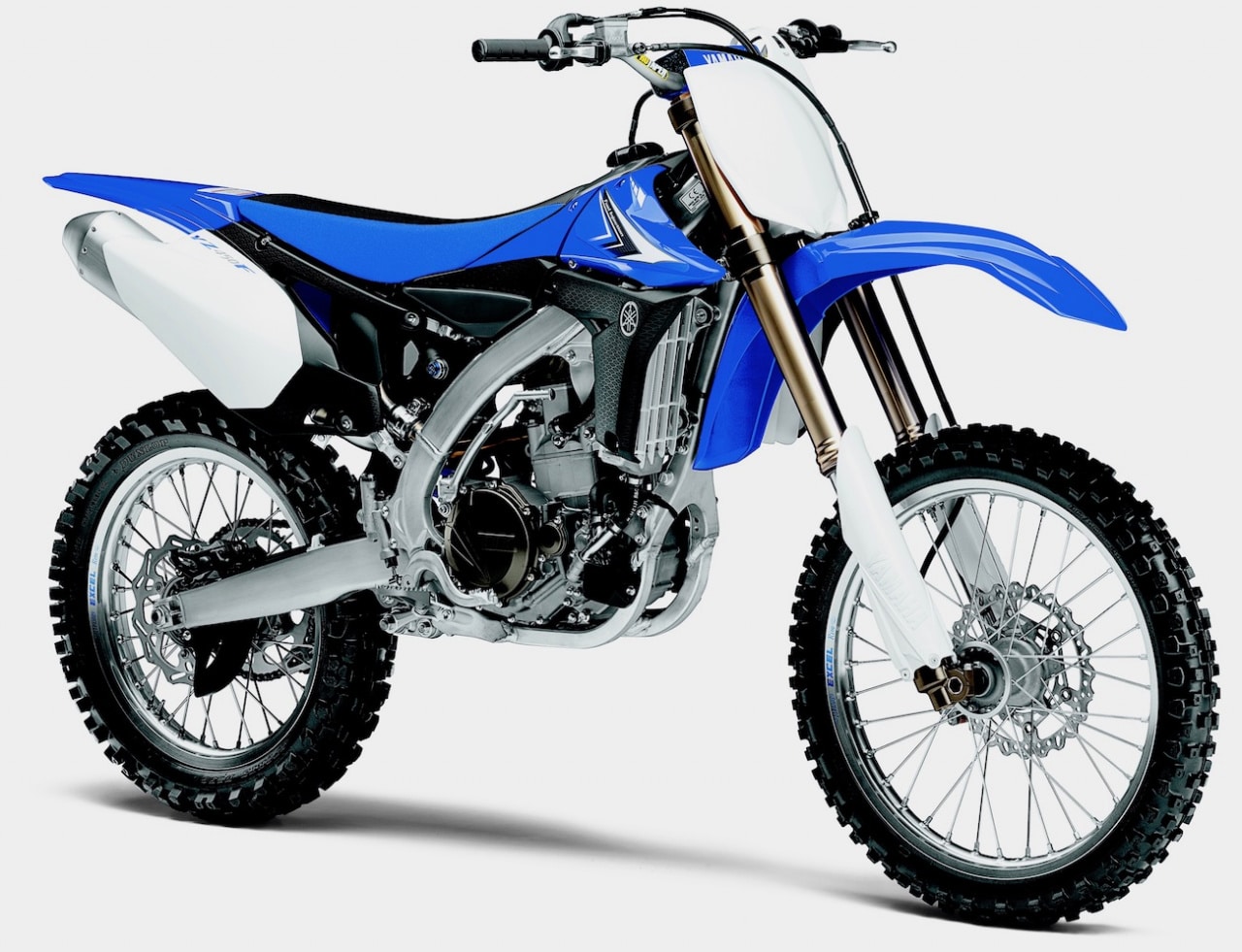 The 2010 Yamaha YZ450 was the first model of the ten year generation of backwards, downdraft engine designs.
The 2010 Yamaha YZ450 was the first model of the ten year generation of backwards, downdraft engine designs.
2010. This was the first fuel-injected, downdraft, four-valve YZ450F. The throttle body was a 44mm Keihin EFI. The YZ450F cylinder was tilted 8.2 degrees rearward (and given that the 2009 YZ450F engine was tilted forward 4.5 degrees, that was a 12.7-degree shift). It had a 2mm-larger bore (97mm) and 2.6mm-shorter stroke (60.8mm). The crank was offset 12mm, and a four-valve head replaced the previous Genesis five-valve head. On the chassis, the fork offset was reduced by 3mm (25mm to 22mm), the head angle was steepened 0.1 degrees and the weight bias moved rearward by 2 percent. The 2010’s Kayaba SSS forks had 10mm more stroke (from 300mm to 310mm), were 7mm longer, and had 10 percent more low-speed compression damping. The fork tubes were 2mm smaller in diameter where they passed through the top triple clamp. The Playstation-like GYTR Power Tuner enabled custom mapping.
2011. The only updates for the 2011 YZ450F were a new clutch actuation arm and two-tone white and blue radiator wings.
2012. The 2012 YZ450F updates included new mapping and a 42mm-longer muffler (with a 3mm-smaller core). The 48mm Kayaba forks got new valving, while the 50mm Kayaba shock received a new rebound adjuster oil passage, less low-speed rebound and more high-speed compression. On a durability note, the locating pins on the shift forks were changed to circlips.
2013. The only changes for 2013 were a white rear fender and black handlebars.
2014. The 2014 YZ450F engine’s intake cam had 0.20mm less lift. The intake valves’ diameters were increased from 36mm to 37mm. The exhaust valves were upped from 30mm to 30.5mm, and a flat-top piston replaced 2013’s domed piston. The engine was wet-sumped and the oil tank removed. Third gear was moved closer to second gear to close up the gap. The airbox volume was 256-percent larger. The 2014 YZ450F was 14mm narrower at the radiator wings and 22mm lower at the seat with a 14mm shorter wheelbase. The frame’s head angle was 27.08 degrees instead of 26.95 degrees, and the head tube was moved back 10mm. The front-axle was increased from 20mm to 22mm. A 49-tooth sprocket replaced 2013’s 48, but a new primary gear made the gear ratio similar to the 48-tooth ratio. The current wraparound exhaust system replaced the corkscrew-like Tornado system.
2015. The 2015 YZ450F‘s SSS forks featured new valving, stiffer fork springs and redesigned fork-tube wall thickness. It had black anodized Excel rims, Dunlop MX52 tires, quarter-turn Dzus fasteners on the airbox cover, revised mapping and a 20-percent-lighter throttle return spring. The 2014’s previous aluminum lower motor mounts were replaced by steel plates. In yet another gearing change, the 49-tooth rear sprocket was changed back to 48 teeth. For reliability, the gear stop lever was changed from a bearing to a roller.
2016. The YZ450F’s 2016 exhaust cam had 0.3mm more lift, 8 degrees less duration, and, when combined with 0.1mm less lift on the intake cam, stiffer valve springs and new dog shapes on the gears, the 2016 engine saw an increase in power. The fork offset was changed back from 22mm to 25mm, and the rear shock spring went from 58 N/mm to 56 N/mm. The fork springs were stiffer, the swingarm pivot forgings widened by 12mm, the head stays were made thicker and the footpegs were lowered 5mm. Both a 270mm front brake rotor and launch control system were added
2017. Yamaha recessed the holes for the gas tank cover’s Dzus fasteners in the 2017 YZ450F. An improved countershaft seal, updated oil strainer and improved metal in the rear rotor helped durability. Yamaha also switched from MX52 tires to Geomax MX3S tires.
2018. With the addition of electric starting and Wi-Fi mapping, the 2018 YZ450F jumped out of the past. The engine got new camshaft profiles, a redesigned crankshaft, a higher compression piston and a 44mm Mikuni EFI throttle body (instead of Keihin). The cylinder was slanted 2 degrees more upright, the radiators were enlarged and the muffler moved farther forward. The 2018 radiator shrouds featured new air ducts, and a seat that was 9mm lower at the front and 18mm lower at rear. The aluminum frame was revised. The 2018 bar mounts were 5mm taller than the 2017 mounts. The now-aluminum head stays were repositioned lower on the cylinder, and the rims were blue anodized.
2019. For 2019 the YZ450F received updated Kayaba SSS suspension valving, more rigid fork lugs, stiffer wheel collars, less drag on the electric starter system, 16-percent-denser seat foam and a blue valve cover. The transmission and clutch were overhauled for a more direct connection, as well as enhanced durability. Revised gears with a wider surface area, updated clutch plates and a stiffer outer pressure plate enhanced the driveline.
 2020 Yamaha YZ450F engine got a major makeover.
2020 Yamaha YZ450F engine got a major makeover.
Q: WHAT DID YAMAHA CHANGE ON THE 2020 YZ450F ENGINE?
A: The 2020 Yamaha YZ450F has seen the most changes in years. Not fluffy stuff, but true-to-life improvements. Let’s start at the top.
(1) Head height. The cylinder head’s height is 10mm narrower. The blue valve cover is cast from magnesium, but actually fits over the head like a cap instead of sitting on top of it. The breather outlet is housed in a separate chamber on the right side of the valve cover. The head pipe is mounted to the head with two studs instead of the previous three.
(2) Cams. The two camshafts have been moved 14mm closer together and sit on 6mm-lower cam towers. The lower cam towers require 6mm shorter valve stems. The valve angle is 7 degrees more upright. As for the valves themselves, they are unchanged, with 37mm intake valves and 30.5mm exhaust valves (first adopted in 2014). The new valve angle allows the valve port shape to be improved for more air flow when the valves are fully open.
(3) Combustion chamber. With the new valve angles and cam positions, the combustion chamber is reshaped. The volume is reduced 6.65cc, which, in conjunction with a new piston crown shape, raises the compression from 12.9:1 to 13.0:1. The interaction of the new combustion shape and recessed piston crown allows for the spark plug to extend 4.9mm into the burn area. The top rings’ tension has been increased by 10 percent to aid in sealing the increased high-compression ratio.
(4) Connecting rod. Those of you who raced two-strokes in the late ’80s and early ’90s will remember when racers “long-rodded” their YZ250s. Guess what? Yamaha remembers it too. For 2020, the YZ450F gets a 1.5mm longer connecting rod. Long-rodding an engine does not affect the bore and stroke. Why did Yamaha long rod the 2020 YZ450F? They wanted to reduce friction loss in the cylinder. The connecting rod is not only moving up and down, but, due to the rotation of the crankshaft, it is simultaneously moving sideways. This sideways action places load forces on the piston as it is pushed against the cylinder’s walls. This is called thrust action. A short rod drives the piston harder into the sides of the cylinder, while the less acute angle of a long rod’s motion reduces the side thrust action. In the YZ450F’s case, the longer rod reduced friction by 2 percent. The reduction in friction results in less heat, quicker rev and a major reduction in decompression braking when coasting into corners.
(5) Miscellaneous. A new stock ECU map is spec’ed to improve low-rpm throttle response. The exhaust pipe is 3.2mm larger where it meets the first turn of the mid-pipe (38.1mm to 41.3 mm diameter). The regulator and rectifier are now bundled into one unit.
Q: HOW DOES THE 2020 YAMAHA YZ450F RUN ON THE DYNO?
A: MXA was impressed by how usable the 2020 powerband felt compared to previous YZ450F engines, but not enough to make unsubstantiated claims like, “Strongest low-end of any 450,” “Impressive in the meat of the midrange,” “Puts more power to the ground across the board,” “More powerful than the 2019 engine at every step on the curve.” These are all nice sentiments, but in most cases they aren’t accurate.
First, in consecutive dyno runs, the 2020 YZ450F was not more powerful than the 2019 YZ450F at every step on the curve. It was more responsive off idle (from 4500 rpm to 6000 rpm) than last year’s engine; however, after 6000 rpm, the 2020 horsepower and the 2019 horsepower were spitting images of each other up to 8300 rpm. Where the 2020 engine shows its oats is from 9000 rpm to sign-off at 11,200 rpm. Don’t think that we are pigeonholing the 2020 YZ450F as a top-end only engine, because it has excellent pulling power from bottom to top. But, if you are looking for a niche where the 2020 YZ450 is superlative, it is on top.
How does it rank? The 2020 YZ450F ranks fifth in horsepower at 6000 rpm (only beating the 2020 RM-Z450). At 7000 rpm, it ranks sixth (beating out no one). At 8000 rpm, it only beats out the 2020 KX450F. At 9000 rpm, it moves up to the fourth most powerful engine (beating the RM-Z450 and the KX450F). As the rpm climb to 10,000 rpm, the YZ450F begins to gain momentum and is third behind the 2020 Honda CRF450 and the 2020 KTM 450SXF. Finally, at 11,000 rpm, the YZ450F’s 58.46 horsepower takes the top prize; however, it doesn’t win the peak horsepower trophy, as the Honda’s 59.74 horsepower at 9600 rpm edges out the YZ450F’s 58.56 at 9700 rpm by more than a horse.
Q: HOW DOES THE 2020 YAMAHA YZ450F RUN ON THE RACETRACK?
A: As you can tell from the dyno info above, the YZ450F reaches its peak horsepower at a rather high 9700 rpm. That means you have to rev it to get the most out of it. How far do you have to rev it? In comparison to the 2020 KTM 450SXF, which makes its peak horsepower at 8800 rpm, you need to rev it almost 1000 rpm more (and when the orange bike is at peak, it is making 2 horses more than the YZ450F). Making maximum horsepower sooner makes it more accessible to a wider range of riders. But, don’t let the 2020 Yamaha’s high peak rpm number scare you.
On the track, you would never know that the YZ450F is a high-rpm 450. The YZ450F rolls through its broad powerband without any dips or flat spots. It is so progressive that it is almost linear. If it has a flaw, it is that the initial throttle response is too aggressive. It burps the power on, which can unbalance the chassis (we ironed this out with a map change). Apart from that minor faux pas, it is a third-gear maven. It has the ability to pull a taller gear without any drama. The ability to do second gear turns in third gear is the “Unwritten Golden Rule of Motocross.” Why? Half throttle in third gear delivers a higher miles-per-hour speed than wide open in second gear.
Every test rider noticed that the 2020 YZ450F had less decompression braking in off-throttle situations. Thanks to the 2020 YZ450F’s long-rod engine and 12mm offset crankshaft, the new YZ450F coasts with a much freer feel than in the past. This two-stroke-like sensation allows for better corner efficiency.
The 2020 YZ450F’s power delivery is its best feature (we bet you thought we were going to say it was the Kayaba SSS suspension).
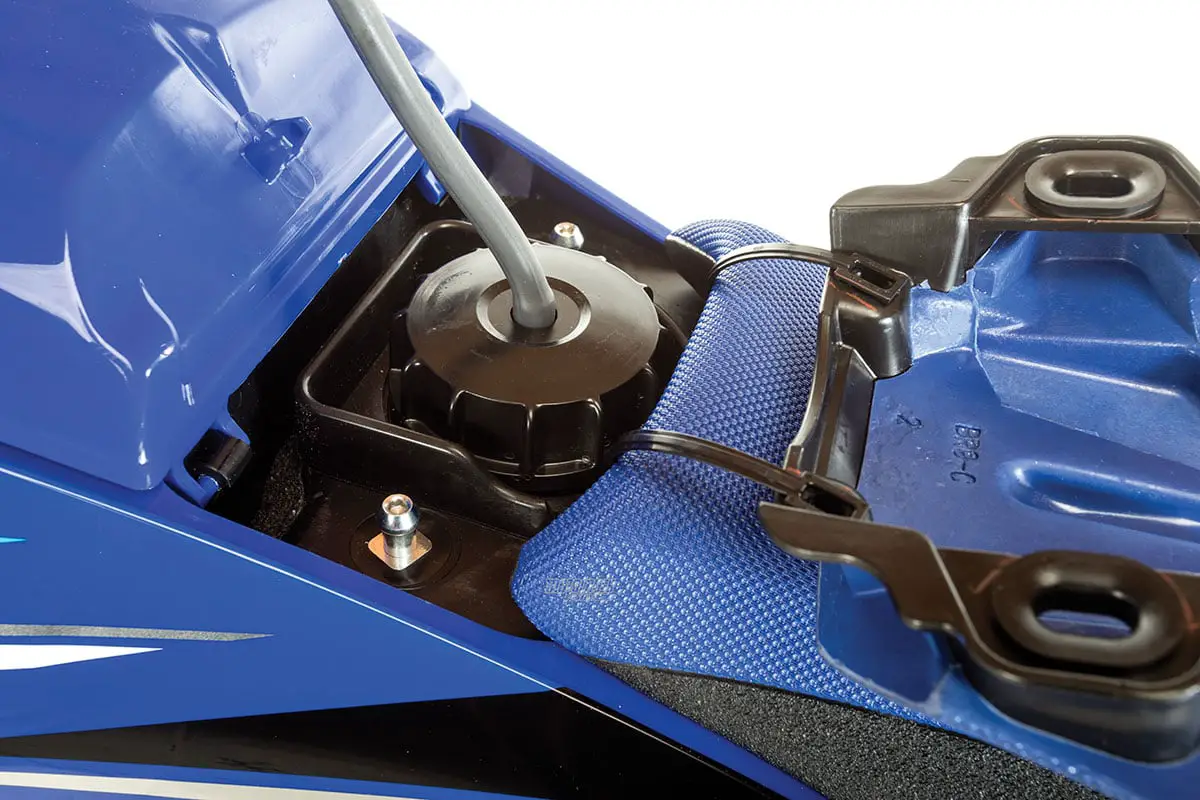
Q: WHAT DID YAMAHA CHANGE ON THE 2020 YZ450F FRAME?
A: The 2020 YZ450F frame geometry and attachment points remain unchanged; however, there are four changes to the 2020 YZ450F chassis.
(1) Main spars. You might have heard that the aluminum spars that run from the swingarm pivot to the head tube have thinner wall diameters for more frame flex. Not exactly true. The wall thickness remains the same 2.5mm as always, but the sides of the aluminum spar next to the fuel tank are reduced by 0.5mm (from 2.5mm to 2.0mm).
(2) Engine cradle. The 3.5mm-wall thickness of the square tubing that goes under the engine, from the bottom of the down tube to the footpegs, has had its wall thickness increased by 0.5mm, but not on all four sides, just the top and bottom of the square tube have been made thicker (from 3.5mm to 4.0mm).
(3) Motor mounts and head stays. In 2015 Yamaha went from aluminum motor mounts to steel motor mounts. In 2016 Yamaha made the head stays stiffer. In 2018 they changed to aluminum head stays and moved them lower on the cylinder and reshaped the new aluminum motor mounts. So, it should come as no surprise that the 2020 YZ450F has reversed course again. The previous 8mm-thick steel motor mounts have been replaced with 8mm-thick aluminum motor mounts, while the head stays have gone from 9.5mm aluminum plates to 6mm steel plates.
(4) Triple clamp. Yamaha whittled material out of the front profile and center thickness of the top triple clamp to decrease rigidity. Additionally, the front axle’s inner diameter was hogged out by 1.4mm (in what Yamaha used to call “increased hollow”).
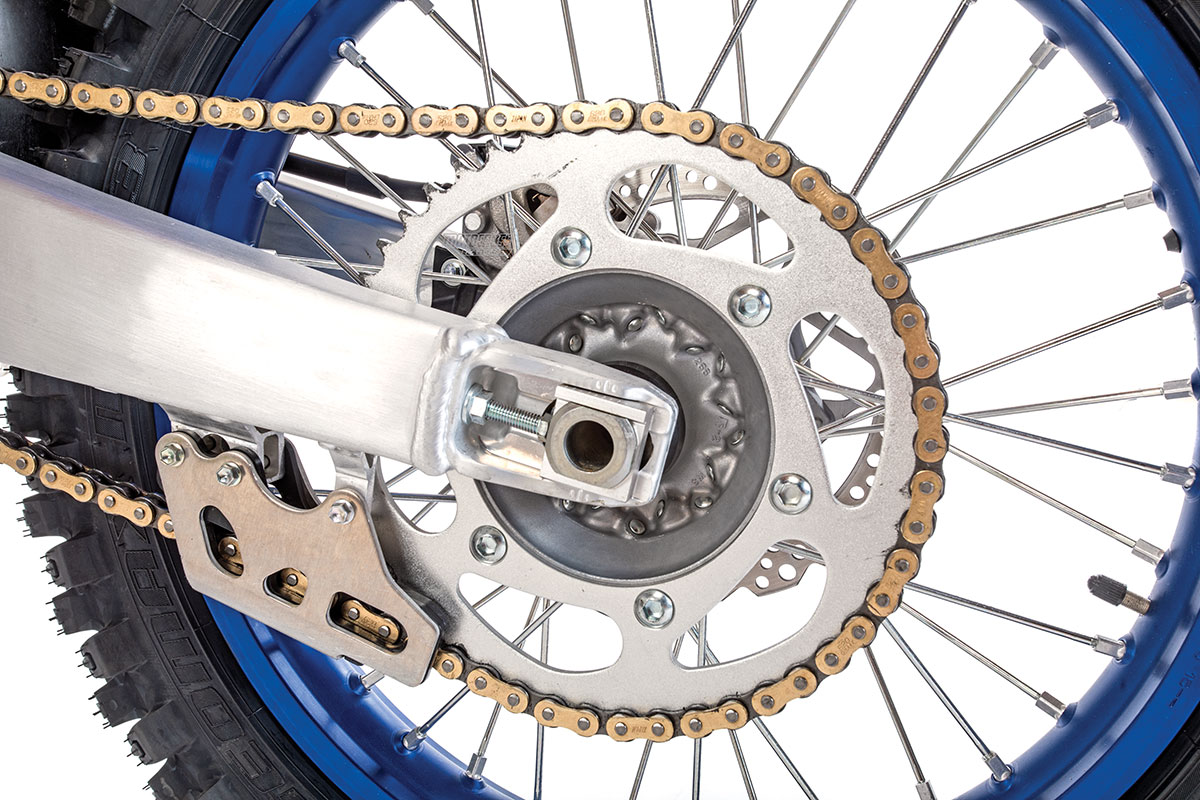
Q: HOW DOES THE 2020 YAMAHA YZ450F CHASSIS PERFORM ON THE TRACK?
A: We are not telling tales out of school by saying the YZ450F’s handling has been the subject of considerable vitriol over the last decade. The potpourri of changes the Yamaha engineers threw at it over the last 10 years were more like Band-Aids than fixes.
The 2020 YZ450F represents the first time that Yamaha’s engineers focused on a comprehensive program to address rider complaints. The plan was to stiffen the rear of the frame and soften the front. The result is that the front of the 2020 YZ450F feels more planted, not just on the entrance to corners but all around the track. The two most noticeable improvements are that the front end doesn’t wiggle and wander as much at corner exit and the rear end doesn’t wallow under acceleration. On the older models, the front end never wanted to take a set. It felt as though the front wheel was castering—and that looseness in the front wreaked havoc on the rear as the bike became more unicycle than bicycle.
In short, we like the handling of the new chassis, especially at corner entrance, when leaned over in a rut, and when front-tire accuracy is of the utmost importance. The source of most of the handling improvements is how effectively the YZ450F engine churns out its very progressive, steady and non-confrontational style of power.
We don’t expect riders who have been turned off by previous YZ450Fs to jump right on the chassis and fall in love, because the chassis isn’t as lovable as the powerband. Riders who tried YZ450Fs in the past and felt that they were big, bulky, wide, tall and heavy aren’t going to feel those fairly accurate sensations disappear.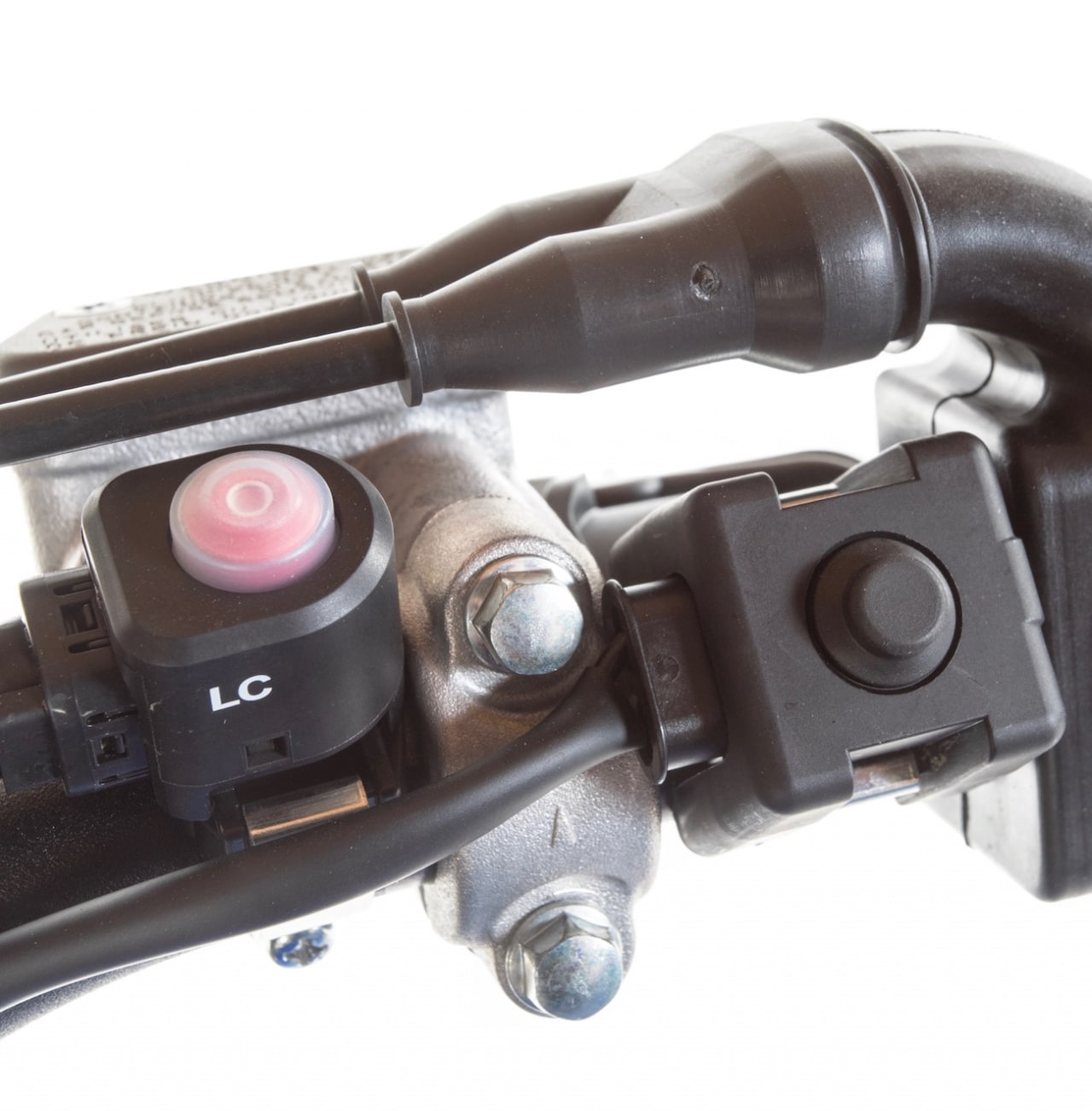 The electric start button is on the right, while the launch control button is labeled “LC.”
The electric start button is on the right, while the launch control button is labeled “LC.”
Q: HOW DID THE 2020 KAYABA SSS SUSPENSION PERFORM?
A: MXA test riders have loved Yamaha’s SSS suspension for the last 13 years. Since 2006, Yamaha has had the best forks on the track, but more of its competitors are switching to Kayaba forks to close the gap. Yamaha has responded to the interlopers by going stiffer. Yamaha’s goal was to get the forks to ride higher in their stroke and hold up better under loads, which is strange, because the forks felt like the front of the bike was down. To compensate, we tried dropping the rear sag a few millimeters, but the shock got harsher. In the end, we raised the forks up in the clamps and stayed very close to the stock compression and rebound settings at both ends.
The shock had a stagey feel, where it would drop, then stop and drop again. This can be ironed out with the high-speed compression and rebound clicker.
Q: WHAT ARE THE THINGS THAT 2020 YZ450F RACERS SHOULD KNOW?
Consider this the cheat sheet of things that YZ450F should know about the 2020 model. These are things that we emphasize and focus on with the YZ450F.
Ergos. The 2020 Yamaha YZ450 has the worst ergonomics of all the 2020 450 motocross bikes. It is wide, tall, bulky and heavy. And that doesn’t take into account that it weighs 15 pounds more than the lightest bike in its class. The MXA wrecking crew focused on two areas to make the YZ450F more comfortable.
Handlebar position. For some reason, probably because Yamaha’s in-house test rider Travis Preston has long arms, Yamaha moved the handlebars 16.5mm farther forward. Yamaha wanted to get the rider farther forward on the bike, but the width of the gas tank nullifies this. The majority of MXA test riders thought the bar setup was awkward when sitting and lessened their ability to get added leverage on the bars when there were pitch issues. We put the bar mounts back to where they were last year (in the back hole with the bar mounts rotated forward).
The seat. With the stock seat, you feel like you are sitting in a hole—an unpadded hole. How unpadded? In 2019, Yamaha increased the foam density by 16 percent. Guess what? They increased it by 10 percent more in 2020. Anyone betting on another 10 percent in 2021? For our taller test riders, we ran a 20mm-taller GYTR seat (and we put the handlebars back to the stock 16.55 farther-forward position). This setup helped lessen the cramped footpeg-to-saddle height for tall riders; however, short riders hated this mod because the bars lifted their arms up. And with the tall seat, they couldn’t touch the ground.

Maps. Yamaha has a dedicated button on the clutch side of the handlebars that allows the rider to switch between the stock map and a performance map (the performance map will be indicated by the button lighting up), As a bonus, you can change maps on the fly. If you do nothing, then both maps will have the identical stock map—regardless of the light. Yamaha is the only brand that allows you to change maps with your smart phone. The fuel and ignition maps have 16 programmable boxes, and you can change the fuel in 2-percent increments and advance/retard the ignition in 1-degree increments. Most MXA test riders preferred the TP-3 (Travis Preston) map over the stocker or the other pre-programmed maps on the Yamaha app. The Preston map took away the jerkiness at low throttle settings and produced a much smoother overall powerband.
Air filter. We hate the 2019-2020 Yamaha YZ450F airbox and air filter design. Yamaha uses a flat piece of foam that lays on top of the backfire screen like a piece of toast. Every time the engine pulses, which can be 10,000 times a minute, the air filter vibrates against the wire screen. The constant pulsing and suction dries up the air filter oil and eventually sucks dirt through the dry spot in the foam. There are two fixes. First, run a Twin Air YZ450F air filter (part number 152221). It features a much thicker foam filter plus a plug-in, top-hat style spacer that lifts the Twin Air filter off the backfire screen to lessen the repetitive pounding against the screen. Second, Twin Air offers the best fix in the form of its Power Flow kit. It includes a new airbox sealing ring (that eliminates the backfire screen), aluminum cage (that goes inside the air filter instead of on top of it) and dome-shaped air filter (that replaces the piece of toast). If you don’t replace the stock air filter with the Twin Air design, be sure to check it constantly. If you see a white circle in the center of the air filter, re-oil the filter immediately. As a side note, we used a leftover, Twin Air, rivet-on, humpback, airbox cover from the 2018 YZ450F Power Flow kit to double the air volume of our YZ450F airbox.
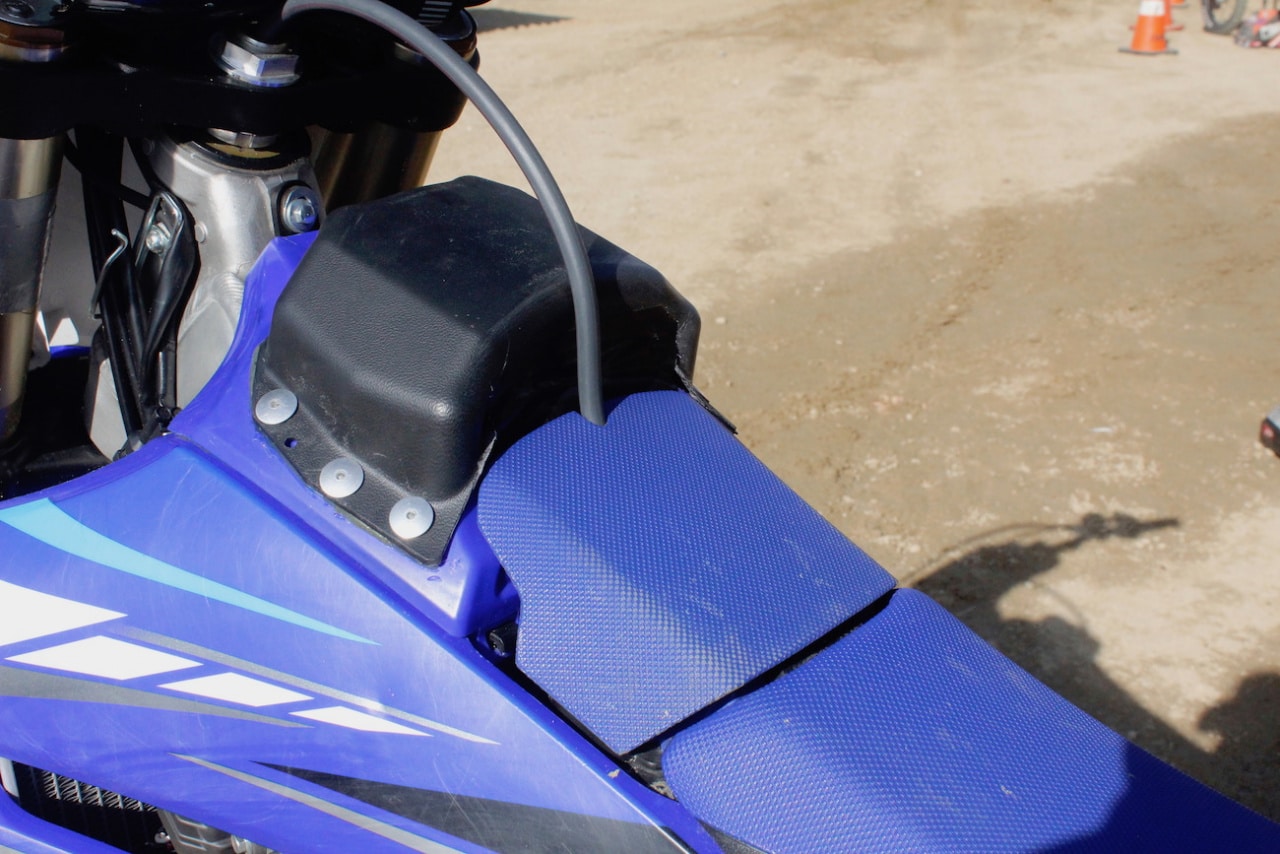 In an attempt to get more air into the YZ450F engine, MXA cobbed together a Frankenstein airbox cover.
In an attempt to get more air into the YZ450F engine, MXA cobbed together a Frankenstein airbox cover.
Gearing. In 2018, the YZ450F gear revved out too quickly, only to be met by a sluggish third gear. So, MXA switched the stock 13/48-tooth gearing for a lower 13/49 combination. We liked the gear ratios a lot better because they made third gear more accessible. When the 2019 model was released, lo and behold, Yamaha had adopted MXA’s “add one tooth on the rear” solution. The 2020 YZ450F still has the 13/49, and it is about perfect.
Weight. At 238 pounds, the 2020 Yamaha YZ450F is 3 pounds lighter than the very heavy Suzuki RM-Z450 but 15 pounds heavier than the 450 class lightweight champion, the 223-pound KTM 450SXF. You can’t do much about the majority of the bulk, but you would be well served to focus on the unsprung weight. The first thing to look for is lighter tires than the stock Dunlop MX33 tires.
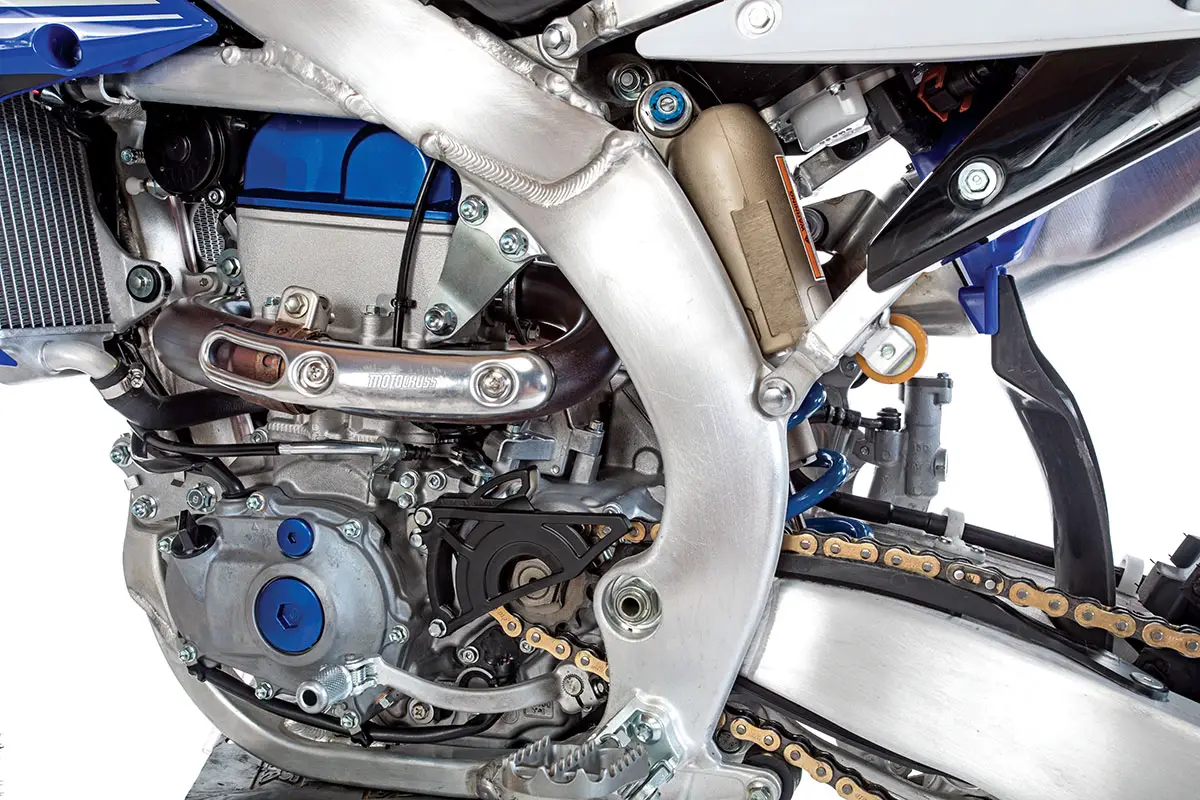
Q: WHAT DID WE HATE?
A: The hate list:
(1) Handlebar position. Yamaha lowered the handlebars by 5mm, which we like, but the OEM position is 16.5mm farther forward. Yamaha wanted to get the rider farther forward on the bike, but the width of the gas tank voids this. The majority of MXA test riders thought the bar setup was awkward when sitting and lessened their ability to get added leverage on the bars when there were pitch issues.
(2) Weight. Do you know what would make the 2020 YZ450F turn better, accelerate harder, stop quicker and have better suspension performance? The answer is a massive weight loss. The YZ450F weighs 15 pounds more than the KTM 450SXF. Without fuel in the tank, it weighs 238 pounds (which is 247 pounds when fueled up).
(3) Exhaust pipe. When you put the cylinder head on backwards, the pipe has to go forwards before it can go backwards. It is also a pain to remove (two studs or three). Sadly, Yamaha has no intention of turning the cylinder around—even though it is getting closer to being upright.
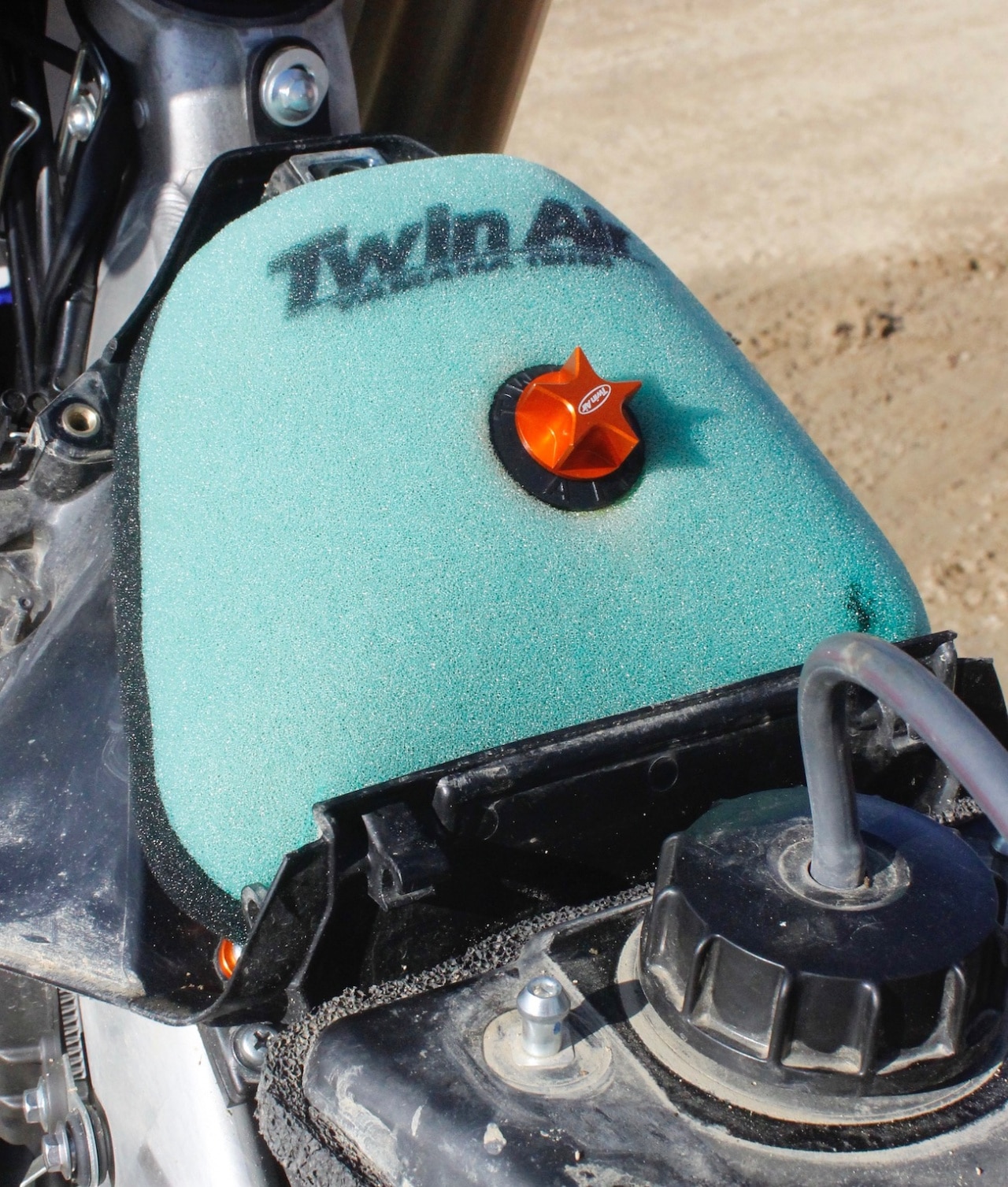 MXA always changes to a Twin Air filter (the one with a top hat washer underneith to lift the air filter off the wire screen) or, as shown above, the Twin Air Power Flow air filter kit that has the cage inside the air filter.
MXA always changes to a Twin Air filter (the one with a top hat washer underneith to lift the air filter off the wire screen) or, as shown above, the Twin Air Power Flow air filter kit that has the cage inside the air filter.
(4) Air filter. We think that this is the worst airbox and filter combination on the track. It, too, cannot be fixed without turning the cylinder around. For 2020 Yamaha added a grommet to the center of the foam to keep it from tearing around the center pin.
(5) Seat. You feel like you are sitting in a hole on the YZ450F. In 2019, Yamaha increased the foam density by 16 percent. Guess what? They increased it by 10 percent more in 2020. Anyone betting on another 10 percent in 2021?
(6) Grips. Almost any aftermarket grip is better than the stock Yamaha blister producers.
(7) Blue rims. We prefer silver rims because blue and black rims get beaten up by roost and scratched by tire irons.
Q: WHAT DID WE LIKE?
A: The like list:
(1) Engine. A great powerband—made great by the fact that it feels more powerful than it really is.
(2) Reliability. Nothing is as reliable as a Yamaha YZ450F. It will last forever.
(3) Map button. There is a two-position map button on the left side of the handlebars (the launch control button has been moved to the throttle side.) Map 1 is engaged when the button in not lit. Map two is engaged when the button lights up. You can change maps on the fly.
(4) TP-3 map. Most MXA test riders preferred the TP-3 (Travis Preston) map over the stocker or the other pre-programmed maps on the app. The Preston map took away the jerkiness of initial throttle tip-in and produced a much smoother overall powerband.
(3) Wi-Fi mapping. You can remap your 2020 YZ450F with your smart phone. The fuel and ignition maps have 16 programmable boxes, and you can change the fuel in 2-percent increments and advance/retard the ignition in 1-degree increments.
(6) Clutch. Yamaha didn’t make any changes to the 2020 clutch, but because of the broader and more filled-in powerband the clutch worked better and lasted longer. We still think stiffer clutch springs would extend the life even further.
(7) Brakes. The Japanese manufacturers are finally reacting to 10 years of Brembo dominance. For 2020, Yamaha has a more rigid front caliper with the piston size increased from 22.65mm to 25.4mm. Additionally, the front brake pads are 29.2 percent larger (by making the pads 10.4mm longer and 1mm taller). To allow the new pads to work more effectively, Yamaha redesigned the front rotor to have 16 percent more surface area. Additionally, learning from Kawasaki’s mistake of upping its rear brake rotor to 250mm, the 2020 Yamaha YZ450F’s rear disc has been reduced to 240mm. The rear also has a new caliper and hanger bracket.
Q: WHAT DO WE REALLY THINK?
A: We had begun to think that Yamaha would never cure the ills of the YZ450F. And we certainly didn’t think that a new engine would be more important than a new chassis.

MXA’S 2020 YAMAHA YZ450F SETUP SPECS
This is how we set up our 2020 Yamaha YZ450F for racing. We offer it as a guide to help you find your own sweet spot.
KAYABA SSS FORK SPECS
Yamaha’s SSS suspension is a sure thing. It was the best fork back in 2006, and it has stayed on top of the heap with minor tweaks every couple years. Maybe someday the coil spring forks of the green, yellow, and red bikes will catch up to SSS, but not in 2020. For hardcore racing, these are MXA’s recommended 2020 Yamaha YZ450F fork settings (stock settings are in parentheses).
Spring rate: 5.0 N/mm
Oil quantity: 290cc
Compression: 9 clicks out
Rebound: 8 clicks out (9 clicks out)
Fork-leg height: 5mm up
Notes: For 2020, Yamaha has refined what were already the best forks on the market. What’s best about them? They work for Beginners, Novices and AMA Pros. They don’t care if you’re thin or fat, tall or short. There’s a setting for everyone. Be very careful with the compression clicker. One clicker is the equivalent of a couple clicks on other brands of forks.
KAYABA SHOCK SETTINGS
On the track, the shock settled a lot better than it did last year. It didn’t wallow as much thanks to stiffer mid-speed valving. Most MXA test riders went out on the high-speed compression to soften the feel on square-edged bumps. The rebound could be made to work by going one click in either direction. We used the rebound to settle the chassis, especially on the entrance of corners. For hardcore racing, these are MXA’s recommended 2020 YZ450F shock settings (stock settings are in parentheses).
Spring rate: 58 N/mm
Race sag: 105mm (100mm stock)
Hi-compression: 10 turns out
Lo-compression: 12 clicks out
Rebound: 11 clicks out
Notes: We thought the 58 N/mm shock spring was going to be too stiff for slower and lighter riders, so we had the 2017 56 N/mm spring with us just in case. Amazingly enough, we had riders as light as 130 pounds still get acceptable race sag from the stiff spring.
VIDEO TEST OF THE 2020 YAMAHA YZ450
2020 MXA 450 SHOOTOUT VIDEO






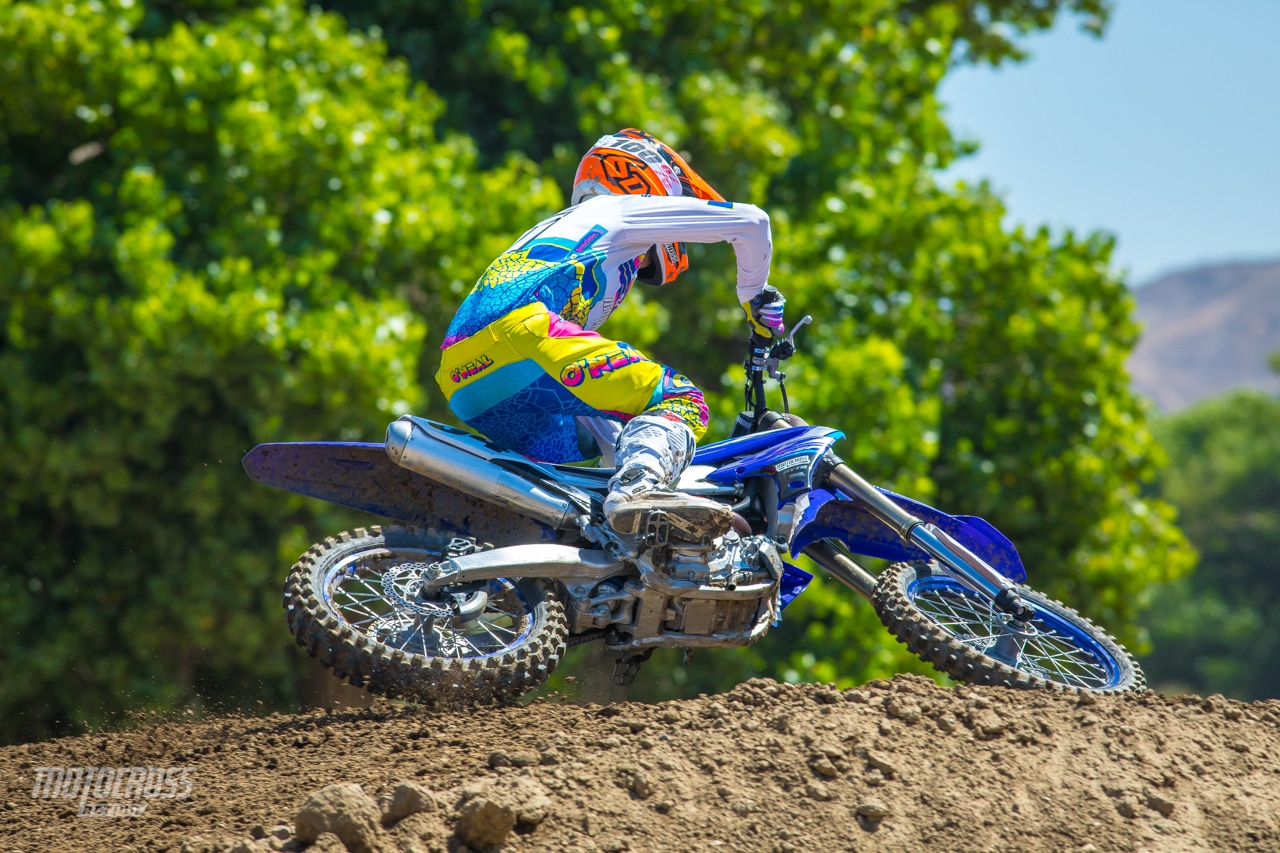



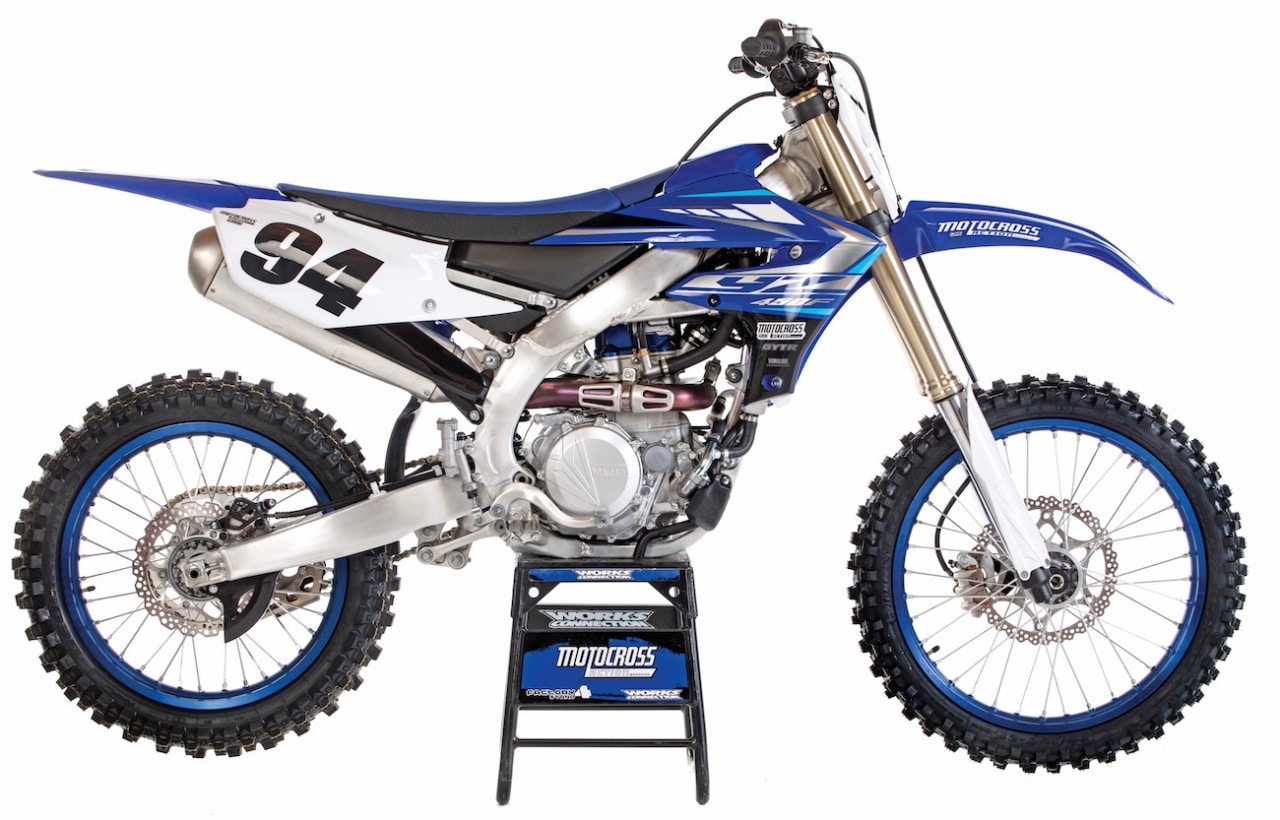

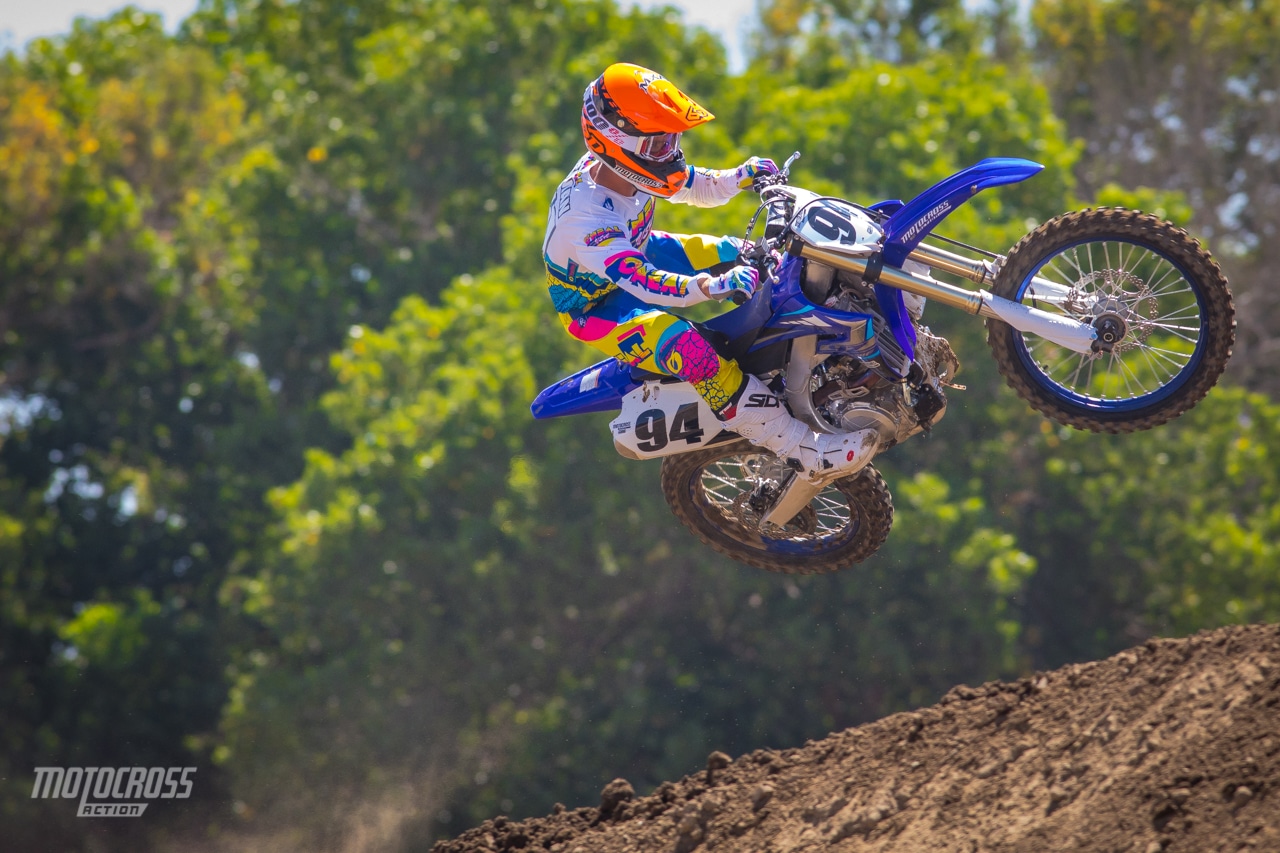



Comments are closed.